You may think a lot about the quality and type of food you eat, but have you ever thought about what you cook it in?
If you haven’t, now is the time to start because cookware may be one of the most toxic items in your home. It can add toxins to the food you cook (particularly ones known as “forever chemicals”) and even release toxic fumes when heated to a certain temperature.
And unfortunately, the most dangerous cookware also happens to be the most popular.
The Most Dangerous Type of Cookware
In an age of convenience, it should come as no surprise that the most popular type of cookware is the nonstick variety. A whole generation has now grown up without the annoyance of food sticking to the pan- although at an unseen price.
Conventional nonstick coating was invented around the 1940s (more on that in a minute). It has become increasingly popular ever since then, becoming almost a household staple.
However, it has come under heavy scrutiny in recent years for harmful health effects. One of the main chemicals in the original nonstick coating was phased even out in 2013 because there were so many health concerns connected to it.
Due to the phase-out of that chemical, cookware companies would like to convince you that their products are safer now. But you might not want to believe those who benefit from nonstick coatings to the amount of billions of dollars without doing a little research of your own…
Where Did Nonstick Cookware Come From?
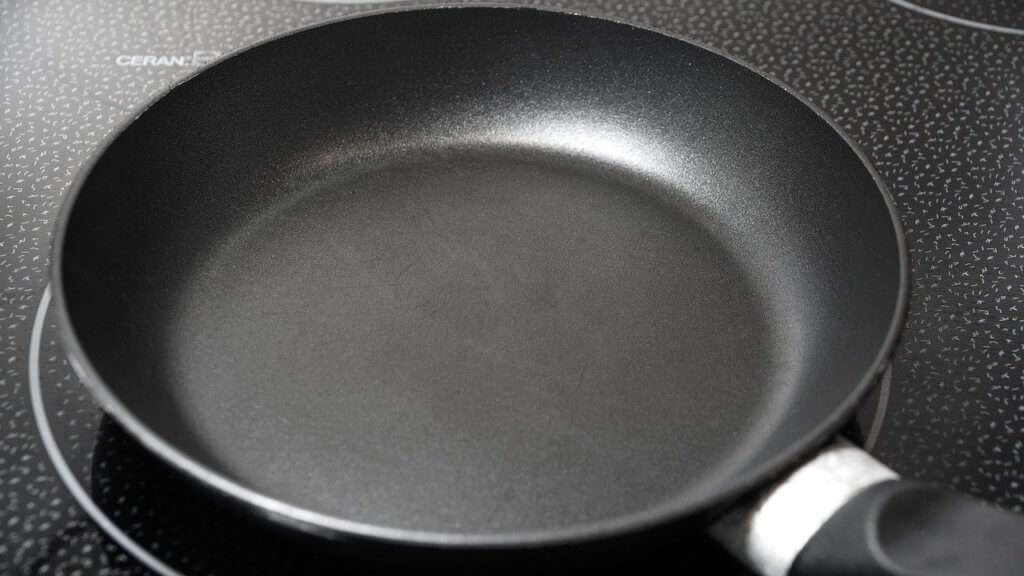
The most recognizable brand name for the nonstick coating you typically find on cookware is Teflon. It was originally created, though not on purpose, by a man named Roy J. Plunkett.
Just before the start of World War II, Plunkett was trying to create a new non-flammable coolant for refrigerators. He was working at the time for a company called DuPont. By accident, he discovered a substance known scientifically as polytetrafluoroethylene.
This new substance was slippery and incredibly resistant to corrosion. It could also withstand both extremely cold and extremely warm temperatures.
Eventually, polytetrafluoroethylene was used to make certain components of the atomic bomb because it was resistant enough to hold up to the corrosive nature of the bomb.
Shortly after the war, polytetrafluoroethylene, which started going by the brand name of Teflon, was applied to cookware. It was hailed as an almost miraculous substance that food didn’t stick to, was easy to clean, and needed little oil for cooking.
Teflon also appeared in other places, including in wire coatings, waterproof fabric, and stain-resistant carpeting.
The Problem With Nonstick Coatings
The main dangers of nonstick cookware come from one group of chemicals: PFAS.
PFAS is short for per- and polyfluoroalkyl substances. This is a group of manmade chemicals that have been nicknamed “forever chemicals” because of how long they persist in the environment and in the human body. They are also a common water toxin.
One of the worst in this group is a chemical called perfluorooctanoic acid (PFOA). It has been one of the most well-researched PFAS for its toxic health effects and also happened to be one of the major chemicals in the original Teflon.
PFOA has been linked to major health issues, including cancer, hormone disruption, and thyroid disease. It has proven to be so potentially toxic that a global ban of PFOA was agreed on by over 180 countries in 2019.
Now, PFOA was phased out of Teflon in 2013, although older nonstick cookware still likely contains it.
The only problem?
New nonstick coatings contain another variation of PFAS that has not been proven to be any safer. Companies don’t have to prove a chemical is harmless before they use it. They just work around a ban on one chemical by creating a new, yet similar, one in the same family that hasn’t been proven harmful- yet.
Specific Dangers of Nonstick Cookware
Contains Chemicals Linked to Serious Health Problems

Let’s look more into the specific health hazards of PFOA and PFAS.
One of the most significant potential dangers is an increased cancer risk from exposure to PFAS. In fact, this was a major reason behind the global ban on PFOA- probable human carcinogenic activity.
PFOA has been linked, in particular, to kidney, testicular, and breast cancer.
Apart from this, animal studies have also shown that PFAS can cause liver and kidney harm as well as reproductive, developmental, and immunological problems. They can also have an effect on your hormones, particularly in relation to your thyroid.
The same research also documented that PFOA and PFOS (another forever chemical) caused tumors to form in animals.
Of course, cooking with nonstick pans that are flaking or scratched will expose you to more concentrated amounts of these chemicals. But that doesn’t mean use of non-damaged cookware is safe. Forever chemicals have proven to accumulate in the human body over time, even through “minor” exposure.
Off-Gasses Toxic Fumes
Another danger is that nonstick cookware, specifically Teflon pans, release toxic fumes when heated to a certain temperature.
This isn’t a new discovery. DuPont (the maker of Teflon) has known about it ever since workers started getting the “Teflon flu” in production factories.
Also known as polymer fume fever, flu-like symptoms can occur when polytetrafluoroethylene (nonstick coating) is heated to temperatures above 350°C (662°F). This includes fever, chills, headaches, and respiratory symptoms.
According to DuPont, these fumes only form at temperatures well above the normal cooking range. However, according to tests conducted by the Environmental Working Group (EWG), this isn’t the case.
The EWG found that a Teflon pan reached 721°F when preheated for just 5 minutes on an electric stovetop burner. It also reached 464°F in just about 2 1/2 minutes, at which temperature DuPont’s own studies have shown that toxic particles are released.
To add to this, at 680°F, several toxic gases were released, including two known carcinogens. DuPont has also stated that Teflon coating will start to decompose at temperatures above 660°F.
“Normal cooking temperatures” aren’t so safe for nonstick cookware after all!
Deadly to Pet Birds

If you still aren’t convinced that fumes from nonstick cookware can be toxic, let’s take a look at a disturbing phenomena: the death of hundreds of pet birds from Teflon off-gassing.
This is a little known danger of using nonstick cookware and particularly of special interest to bird owners.
There are hundreds of cases of fatal bird poisonings that have been called “Teflon toxicosis.” They occur when the birds breathe in fumes from heated nonstick coating that cause their lungs to hemorrhage and fill with fluid. This eventually leads to suffocation and often death.
Once again, this happens during normal cooking methods with nonstick cookware.
For example, a Teflon-lined pan was used to bake biscuits (at 325°F) and the owner’s baby parrots died. In another case, four stovetop burners with Teflon-coated drip pans were preheated and 14 birds died in only 15 minutes.
The list, unfortunately, goes on but you get the picture.
And while this is incredibly devastating for the bird owners, it also brings up another question: What do you think is happening to your lungs when you breathe in these same fumes?
You may not notice any effects, but it’s clear that there are some seriously toxic chemicals being emitted from nonstick cookware.
Harmful During Manufacturing
Using nonstick cookware is bad for your health, but it’s even more dangerous during the manufacturing process. Workers are often exposed to much higher levels of PFAS during production than are found in the finished product.
Back when PFOA was used to make Teflon, one worker was directly involved in mixing the chemicals while she was pregnant. She later gave birth to a son, Bucky Bailey, who was born with one eye out of place and only one nostril. He would later need around 40 reconstructive surgeries on his face.
It was never proven conclusively that this came from PFOA exposure, but he wasn’t the only victim.
Eventually, nearly the whole town of Parkersburg (where the Teflon factory was) sued DuPont through lawyer Robert Bilott. They were tired of mysterious health problems that plagued people in their town, including cancer, thyroid disease, and autoimmune disorders.
These people didn’t all work at the factory, but they were getting sick from water polluted with PFAS and other chemicals from the factory.
In fact, reports have found that before PFOA was phased out, “large quantities were released into the environment during manufacturing processes and are now being found in drinking water supplies.” This is most likely still happening with other PFAS, causing untold damage to the environment, animals, and humans.
Chemicals Keep Accumulating
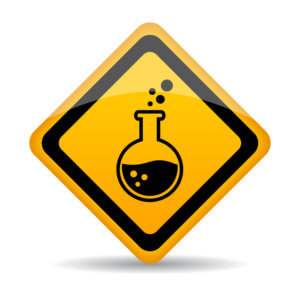
You most likely already have PFOA and other PFAS in your body. These chemicals are present in water, food, and the environment worldwide now and detected regularly in human serum.
One survey that was completed in 2004 showed that PFOA and PFOS were present in 98% of the blood samples tested in the U.S. It’s unlikely that this percentage has decreased since then- and it doesn’t even include other PFAS that haven’t been tested for.
The point is this: You want to avoid PFAS as much as possible, since they are already accumulating in your body.
Conventional nonstick cookware is known to be made with these chemicals, so it’s best to do your body a favor and ditch it.
Other Types of Cookware to Avoid
Aluminum
Aluminum cookware is another popular choice because it’s lightweight and conducts heat quickly. However, aluminum is reactive to both acidic foods (tomatoes, citrus, etc.) and heat. This means it can leach aluminum into your food, which is not a good thing.
Exposure to too much aluminum has been linked to neurotoxic effects. This includes an increased risk of Alzheimer’s, although the link hasn’t been conclusively proven. There is also a potential link to breast cancer.
Copper
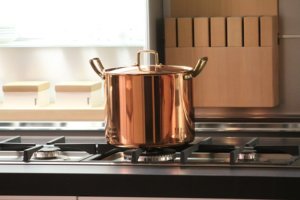
Copper should be considered “borderline” cookware. It heats well and may actually be beneficial for someone who is copper deficient because small amounts of copper can be leached into food.
However, too much copper can contribute to heavy metal toxicity, which is not something you want. Another danger is that some copper cookware has a coating that contains nickel, which can be toxic. If you absolutely want to use copper, look for nickel-free copper coating over a stainless steel lining.
Don’t Forget the Utensils
Nylon or nonstick cooking utensils should be avoided along with nonstick pots, pans, etc. They may contain PFAS and are often made with PVC or chemicals called primary aromatic amines (PAAs).
PVC can off-gas harmful chemicals into your home, including phthalates, which are endocrine disruptors. PAAs are suspected carcinogens– not something you want near your food.
These utensils also usually melt over time, which means you end up eating the chemicals in them.
Top Choices for Safer Cookware Alternatives
GOOD: Cast Iron, Tried and Tested
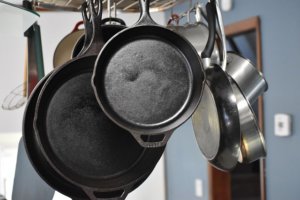
Cast iron may be old-fashioned cookware, but it works as well as it always did. Pots and pans made of cast iron are non-toxic and retain heat very well. They can also withstand higher heats than other cookware and even add a little extra iron to your diet.
One concern or possible benefit of iron cookware, depending on your body, is that a small amount of the iron can make its way into food when cooking. Too much iron in the body can be toxic. However, for those who are iron deficient, this may be beneficial.
Another small downside to cast iron is that it requires a little more maintenance to clean and season your cookware. It also takes a fair bit of muscle to handle a standard skillet!
BETTER: Stainless Steel, Non-toxic and Durable
Stainless steel is a lighter weight option than cast iron but just as nontoxic. It resists corrosion, heats evenly, and won’t flake off into your food. Stainless steel isn’t reactive like aluminum is, which means much safer cooking.
Unfortunately, stainless steel pans are not nonstick, which can take some practice if you aren’t used to it. Some people are concerned because nickel is present in stainless steel in small amounts, although it has not been shown to leach into food. Also, avoid scratching your pans with abrasive cleaners to keep them safe for cooking.
BEST: Ceramic, Natural Nonstick Option
If you want nonstick cookware without the toxicity, look into ceramic. This natural substance has been used for thousands of years for cooking purposes and won’t leach toxins into your food. You can even cook without oil on ceramic coated cookware.
One potential downside is that low quality ceramic can be contaminated with lead and/or cadmium- two toxins you do not want in your body. Ceramic also has a reputation for cracking and discoloring, although new technology has solved this…
Newly Developed Ceramic Cookware for Chemical-Free Cooking
Well aware of the major problems of conventional nonstick cookware, Chefs Foundry developed their own line of completely nontoxic cookware: the P600 Cookware Range.
They used a revolutionary ceramic coating that is both durable and resistant to cracking and discoloration. It goes through a three step process to completely seal the ceramic coating, resulting in natural nonstick cookware that will last.
You won’t have to worry about toxins leaching into your food or about cracking and chipping. Every batch is independently tested for lead and cadmium and, of course, completely free of PFAS.
Look into the Chefs Foundry P600 Cookware line here and start cleaning up your cookware!


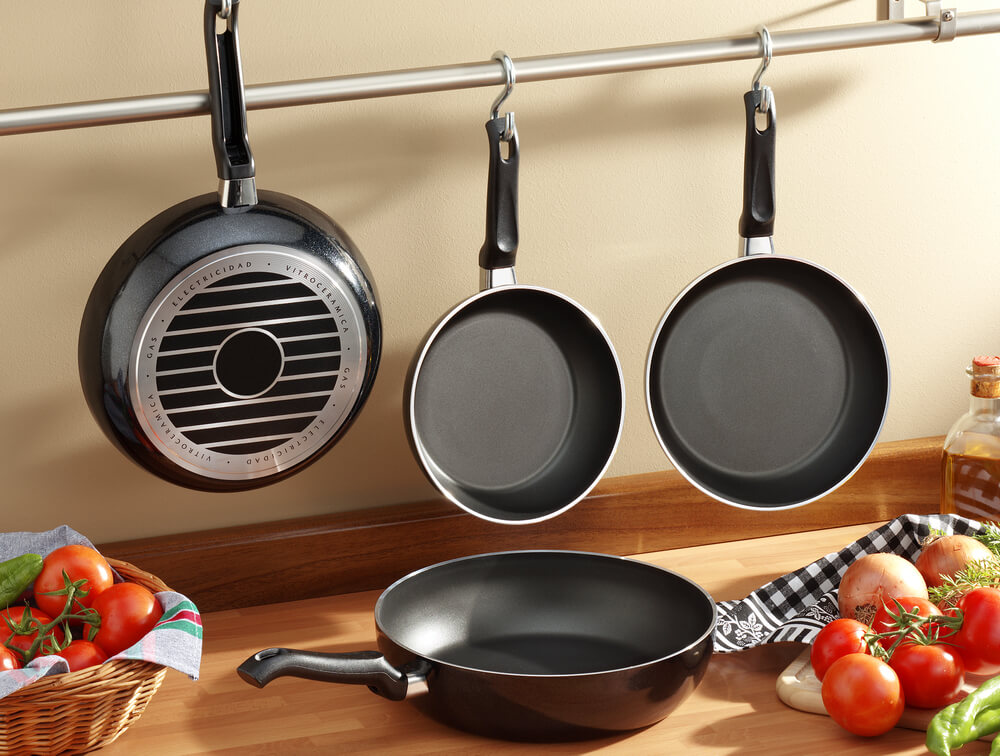
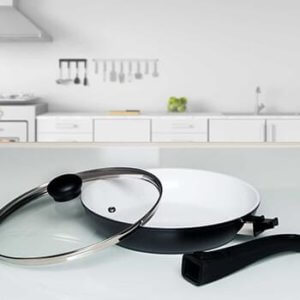
Thank you for this very helpful information!!!
One not mentioned….glass. I have an entire set of glass cookware and LOVE it.
Yes, I appreciate using glass, corning ware and wooden spatulas as well.
Wood can be very toxic due to the chemicals used to prevent the wood from staining. Almost 100% of domestically produced hardwood is “dipped” to prevent the natural greying before it is dried. Im not talking about pressure treated pine. I’m referring to oak, poplar, maple etc. Beware of spatulas, wooden spoons, cutting boards etc.
What would you suggest to use than instead? Silicon?
Yes, what would you suggest using instead of wood spatulas?
What about carbon steel frying pans?
I got rid of my Teflon pans when I acquired my parrots. I also stopped using cooking bags as they too have toxic chemicals. Also, do not use cooking planks in your inside oven.
Thanks for that, Edy! I always wanted to try it.
No mention here, of the risks to health, of microwave and that awful idea of plastic in it and surrounding all food. Is a microwave oven ever safe for use, especially in the confined space of a kitchen.. and for the person regularly exposed to it? Then there is the microwaved food itself..
Thank you for bringing up the plastic on the microwave!! I don’t think people actually realize that they are eating plastic particles when they heat their food in it.
What brand do you mainly use, please? I’ve never considered glass for pan-frying. It’s there such a thing?
Thank you!
yes I had a pyrex glass frying pan that I just dropped and smashed on my floor. My other is stainless steal.
I have a corning wear frying pan I got a long time ago. It is corning wear glass.
I heard early corningware was toxic as well
there are glass, but sadly the one I had was coated. never used it. the rest of the set was not coated.
Great! hard to find, where did you get glass cookware? I have corning ware, but not other glass.
Visions cookware is currently sold worldwide by Corelle Brands, LLC.
Pyrex is made of only ordinary baking glass (typically either borosilicate or soda lime glass) and is highly susceptible to “thermal shock” when exposed to sudden temperature changes. On the other hand, VISIONS is made of transparent Pyroceram.
As mentioned above, VISIONS. Please note that it is a see-through brown in color, not clear. I love stainless steel with a clear glass lid! Go for the heavier-weight! It doesn’t ding up and lasts forever! If it stains, just scrub with Bar Keeper’s Friend.
I’ve picked up Pyrex glass cookware at the thrift stores over the years.
was thinking pyrex is surely safe but can only be used in the oven
Yes, glass is excellent
Thanks for this mention. Do you mind saying what the brand name is of your glass cookware? Thanks!
I love glass too and wish they’d find a way to make skillets and pots and pans from glass so it can’t be broken easily!
I have a Pyrex skillet. No longer manufactured but I’ve found in thrift shops.
Another one not mentioned… non-toxic X-Trema cookware.
Glass is really the way to go for non-toxcity, but it breaks a bit easier than ceramic.
Also, surgical steel does not bleed chemicals like aluminum or stainless steel.
I totally agree with you! I use Pyrex dishes for baking and they are excellent!
That’s what I was thinking. Glass is perfectly safe and only has the downside of being so breakable.
Yes! I have glass also. Two big pots, two small pots and a frypan. LOVE them!
Thank you for this useful information that i did not know and never ever imagined.
Hi, love listening to all your presentations. Thank you!
How about titanium cookware? Have you looked into it? It is supposed to be the best, I’ve heard. Albeit, the most expensive by far.
It is very useful the information you share! Congratulations!
I bought 2 sets of Chefs Foundry and they are fantastic! Wise decision to get these….
I prefer the safest cookware that I can find on the market, as long as it is reasonably priced. I also check labels for important information to make sure tat I am getting the best cookware available.
You are limted to cast iron as far as safety and price. Stainless steel when cheaper scratches easily and that is when you get lead/cadmium/nickel leaching–it is in the under layers. So when using SS it is better to not use metal spatulas or mixing tools. I tend to use wood ones or maybe, with reluctance, silicone sold as safe but am waiting for the shoe to fall on that safety claim
Since I own 5 parrots I am very aware of the dangers of non stick cookware. Thank you for hopefully passing this knowledge on to more people.
Thank you, I’ve been using stainless steel for years and now I know why.
Thanks for this, I have some copper ones but the inside I think is stainless steel but I will be checking this. What about glass? there are some pans branded Visions? and the ones made of clay or stone?
Most copper pots are called “copper clad” because the copper is on the outside. The inside is typically stainless steel. The quality varies by brand and price.
Visions are glass. CorningWare / Corning Ware are “glass-ceramic (Pyroceram) cookware resistant to thermal shock” with glass lids.
Pyrex is glass (measuring cups, bakeware).
Some crockery used in older crock posts / slow cookers was toxic. There is research published online about which are less toxic / safe.
From the beginning I have always had and still use my high quality stainless steel set, use cast iron pans, ceramic or porcelain lined pots as well. I learned a wealth of knowledge from my grandmother at a very young age to never settle for anything that was not natural. I am drawn to high quality cookware. One must be careful with the rock pots and porcelain lined pots with flecks of glitter being another carcinogen. I have always shared the dangers of aluminum Teflon and PVC even used for water lines. Keep in mind the camping pots and dishes to. Thank you for educating folks.
Rock pots? Why? Please explain more.
I think she meant to say “crock” pots not “rock”:pots.
Thank you. The info is very valuable. Could you please tell us about titanium cookware?
Your are soooo right! I bought my first real set of healthy 5-ply stainless steel cookware when I was in college. I even started my credit line from the purchase. And, I still use it 40+ years later. It’s the best! I loved it so much that I sold it for years, door to door, in Miami. Now, I get to teach others how to use it. 🙂
Thanks this is very helpful information. I have to change my cookware asap.
I still use a small fry pan of anodized aluminum which was popular some time ago. Is this harder form of aluminum safe?
Since it is not non-stick I use Trader Joe’s Coconut Oil Spray. Ingredients say no CFCs but I wonder if it’s safe. Thanks.
Anodizing is simply a surface treatment which can wear off over time (even hard coat anodizing will wear off).
Thank you for this valuable information!! I have used cast iron and stainless steel for years!!!
Thank you for this excellent and important article. Very useful.
What about titanium ones?
Thank you so much for this article. I am currently looking for more cookware and I knew that I would purchase more cast iron. I have ceramic as well; however, I was focusing on Teflon. Good to know the best options. Thanks again.
Thank you for this valuable information.
Thank you for the good info on safe cookware. I do really need, also, info on Safe spatula type….silicone? rubber? or what type. Will get rid of the plastic and nylon ones.
I bought a Farberware cook set a few years ago. After reading your article, I discovered the non-stick substance Farberware uses is Polytetrafluoroethylene (PTFE) which does not seem tone a health threat until the pan reaches 260 F. I realize we don’t want to take risks, but I would be interested your further commentary on PTFE. I use my grandmother’s cast iron skillet most of the time and the non-stick for simmering. The wooden spoon is a safe alternative for the non-stick pan surfaces.
Thank you for this information. It can just in time as I need a new pan and now will buy one of the metals in the article.
cast iron for me. thanks for the article
Thank you, Brian. I use a stainless steel pan, with the esternal bottom layer in copper.
I also have a cast iron and a ceramic coated ones but they have gotten a bit old so I’m using them less and less.
Cirio
Very useful information.
Very informative article.
Might I suggest a similar article on ‘Microwave Safe’ plastics that we all use to reheat /cook our foods. Since Tupperware, there has been an explosion in these cheaper ‘MS’ options.
Also is plastic clingwrap safe to use in the microwave?
Thank you
Use Pyrex or ceramic for safety, you just need to cover to keep steam in. Plastic of any form is not earth friendly
Instead of plastic wrap in the microwave, heat in a bowl and cover with a plate. Or if the item is on a medium or smaller sized plate, put it in a parchment cooking bag and fold the opening to close. I have used the same bag multiple times, just let it air out to evaporate any moisture from cooking.
I think is better never use microwave because is damaging the nutrients!!!
Agreed!!
Exactly.. microwaves are dangerous and constantly leach toxins
I no longer have a microwave. I had a fire in my last one and luckily I caught it on time!
I will NEVER buy another one again!
“We all” do NOT use plastic of any kind in the microwave!! For the last 20+ years, we all have known not to use plastic in the microwave! To me, this also excludes clingwrap in the microwave (and of course, not in the oven). A white paper towel works and also silicone lids, I believe. If someone knows of a reason not to use silicone, please give us the facts. I have a microwave popcorn popper made of silicone!
we use a stainless steel pot and quality corn, get great results. Beware of the microwave popcorn in the bag, bad chemicals in it.
No! Never use any plastic container in the microwave. The chemicals in it are toxic and leach into your food.
Hi, Jay,
Why do you want to use a microwave at all? It kills any nutrients in the food and makes it ¨dead¨. The only use for a microwave possibly is to disinfect sponges. But you can use vinegar for that. I would suggest throwing out or giving away the microwave.
Absolutely agree Penelope. Microwave ovens are dangerous. I have a microwave meter and it goes right up into the red when I test a microwave oven. What do these waves do to your food? I havent used one for years and dont miss it.
Very informative article.
Might I suggest a similar article on ‘Microwave Safe’ plastics that we all use to reheat /cook our foods. Since Tupperware, there has been an explosion in these cheaper ‘MS’ options.
Also is plastic clingwrap safe to use in the microwave?
Thank you
PS Stainless steel is very easy to clean if you leave it soak.
Microwaving anything in plastic seems to be very bad since the chemicals leach into the food. There are glass containers available for storing & reheating leftovers.
Never cook food in a microwave oven. The microwaves destroy the nutrients in the food.
This is an old wives tale.
Cooking, in general, destroys some vitamins. But not nearly as many as people think. Vitamin C, thiamine (B1), pantothenic acid (B5) and folate (B9) will all be denatured to varying degrees, but folate requires temperatures well beyond 100°C to destroy it, and pantothenic acid deficiency is virtually unheard of.
All the other main nutrients in food – carbs, fats, proteins, fibre and minerals – are either unaffected or made more digestible by heat. Cooking bursts open plant cells, which increases the amounts available to you. Your body will absorb a lot more of the antioxidants beta-carotene and phenolic acid from carrots, and the lycopene in tomatoes, when they’re cooked. There’s nothing about microwaves that damages food more than other cooking methods. In fact, microwaving can actually preserve nutrients.
Do you have a reliable source to quote for these “facts”? I remember reading a study years ago that showed nutrient analysis of food pre-cooked and after cooked in the microwave and it showed very significant losses due to the high frequencies of the microwaves.
Microwaves will de-structure the water in the food. Google “Structured Water” there is a great you tube by..(can’t remember his name right now) but he is a qualified, reknown scientists who explains exactly what that means and the value we are now learning to understand that that is quite critical to health.
I just read an article about this a few days ago and it actually said that the microwave actually maintains the nutrients better than most forms of cooking.
I agree with Michael. all the research I’ve read says it destroys or greatly reduces certain healthy aspects of the food; be they enzymes or other nutrients. Also, decades ago, Russian scientists experimented with microwave ovens and found that they leaked microwaves Beyond the oven container itself, and would adversely affect humans in several ways; most notably electromagnetic damage to cells, which was more dangerous to neurological functions.
True
Microwaving food in general is a very unsafe practice! There are many studies showing this! Using plastic in a microwave is worse. But since microwaves are soooo convenient, people would rather take chances with their health. Use a conventional oven or a very large/tall toaster oven instead. I cook many frozen TV dinners and other foods in my tall toaster oven and bake for recommended time. Since I live alone I rarely use my full size oven. For years I used Revere Wear stainless steal with copper bottom pans. But they are no longer in business. I found some plain stainless steel pans in a thrift store. I have no problems cleaning stainless steel pans! They clean easily, unless you are “charring” something like steaks. I also have a couple aluminum pans with ceramic coating on the inside, so that makes cooking with aluminum safe. And I have some small ceramic pots and pans. They do take longer to heat up, and hold the heat a long time.
Do you use the double boiler? I use revere ware too, and instead of using the microwave, I heat a lot of things up using the double boiler. In the event this is an unfamiliar term, there is a pot that you put water into, then the pan that fits over/into that, and a lid. Mine is a 3 qt pan.
Explained well. will share with all family. Thank you!
Dr. Neal Barnard’s has a different take on cast iron cookware – If it is used occasionally (like once a month), it’s ok. He does not recommend using it more often. According to Dr. Barnard, a substantial amount of iron is being leached into the food when using cast iron skillets, and too much iron is harmful to the heart and brain[v].
Other plant based drs also say stay away from Cast iron.
Yes! I am a plant-based nutrition coach and teach my clients the dangers and the sustainability of household products.
77 years old and have eaten food cooked in cast iron my whole life.
Not stopping now. I don’t believe I have to much iron. Most people i know of don’t have enough.
Brian, Thanks for these articles and the dad jokes. Keep’m coming!!
One thing not said about cast iron, if you have high iron stores you can add to your iron load by using cast iron. High iron has been indicated in post menopausal women heart attacks, or anyone with high stores, watch your intake.
So true. My Ferritin (stored iron in the body) levels are still high from several years ago when I was primarily using cast iron pans regularly. The levels are slowly returning to normal.
yes, I agree with Yvonne, about the cast iron. my cardiologist is concerned about my high iron already, that it could cause more complications with my heart health.
Excellent information. Trying to reduce harmful chemicals, but cookware tends to be forgotten. I have mainly stainless steel or ceramic, but there is one non-stick. Will review that. Thank you.
Very informative article, Brian. Little did I know about the dangers of non-stick frying pans. I have been using stainless steel cookware forever, but for frying things like eggs which stick to stainless steel, I have used non-stick frying pans once in a while. I would love to buy one of the frying pans you mentioned in the article, but they seem to only sell an entire set. I will make sure to buy a ceramic-coated frying pan next time!
I do a lot of microwave cooking but I exchanged my plastic containers years ago for glass/ pyrex when I found out how dangerous it was.
I still store cooled food in plastic containers in the fridge/freezer but I always decant it into glass or pyres to defrost or cook.
I only use glass to store, cool, cook in microwave and freeze my food. I have never used non-stick pans. Heard about the dangers years ago.
Plastic is an Endocrine disruptor. I don’t any cooked food in plastic containers. Unfortunately, I do have lentils and other things sitting in the plastic bags they come in. I freeze left overs in Pyrex glass bowls as well. I tell everyone but most are not willing to open their eyes or minds to hear me. And water in plastic bottles…..that is a hard pass for me as well.
why not save time, and store leftovers on glass?
They are free if you reuse glass jars.
Gerard Pope
We have used stainless steel since we first heard of PFAS. Stàinless works well when you get used to it
Thanks for this wake-up call.
I have had a set of Le Creuset enameled cast iron pots and pans for decades. They are so old that the enamel has worn or chipped off in places. In one large pot someone in our household of six must have left it on the burner long enough to destroy almost the entire surface on the inside bottom. We still use it for soup and steaming veggies, but I wonder if something weird has been leaching into our food over the years. Ironically we only eat organic, minimally processed food with a dash of sea salt and… um, toxic cookware seasoning?😬
I hear you. I have a large 12″ ceramic coated skillet(Scanpan)that has worn off down to the metal around the edges. It was so expensive that I’ve put off replacing it. I do think that the metal underneath was never meant to be a cooking surface so who know what could be leaching? I try not to use it very much because of that. Maybe I should just bite the bullet so to speak and replace it.
I use ceramic slow cookers, have cast iron casserole dishes and a set of stainless steel pans and glass containers to put food in the freezer. A quick and easy way to clean stainless steel frying pans is to deglaze the pan after cooking to get all the flavours and then soak in bicarbonate of soda with a bit of hot water to form a paste on the pan surface, leave to work its magic, then wash in warm soapy water. Glass trays used in the oven. Pyrex or glass lock and lock containers from Lakeland, for UK readers.
I got rid of my microwave years ago after researching that topic. I use wooden, stainless steel or bamboo utensils.
Hope this information helps someone 😎
Thank you. It sounds like you have done a lot of research and ended up with the best of the best. I, too, love to store everything in glass and have found those glass mason jars to be the best of anything to store leftovers, etc., in the fridge and elsewhere.
Pyrex sold in the UK is licensed and manufactured by Arc International Cookware, and is made of borosilicate glass. This is significantly more resistant to thermal shock than the Pyrex products manufactured by World Kitchen for the US market, which are made of heat-strengthened soda-lime glass.
If your cookware is spelled in lowercase, it’s soda lime. If it is spelled in upper case then it is European and thus Borosilicate.
If you have old PYREX pieces in your cupboard, it’s also made of borosilicate glass and can go directly from the freezer and to an oven temperature of around 300 degrees without shattering.
Wow, thanks! I never knew.
👍👍 Verola helpful. Thank you.
Always look forward to your emails. This was a great one. Thanks for all the time and effort that you put into the research. I always feel I can trust you and your suggestions!
Great Tip I picked up from a friend: To check the toxicity of cookware, and every thing else, do a taste test… put water in the pot/container and cover it, let it sit overnight. Taste the water in the morning. If the water tastes like anything else but water, it is toxic. I do this with all my utensils, glassware, anything in fact that I eat of drink from/with.
Thank you for covering this important topic.
Thank you for this valuable information..I will change most of my kitchen utensils..
Thank you for this… our most recent purchase is a set of ceramic non stick… that still stick so we get out the old cast iron for serious cooking!
Helping a friend get rid of stuff after the death of her husband, we threw all aluminum pots and cookware in the trash and refused to even donate it to good will! Thanks to knowing information like this.
Since I have been taking master classes and reading your articles, I have gone through all my products including face creams, makeup, bath products, shampoo, lotions etc. They all have been thrown in the garbage with my blessings. I now use Purity Woods products, etc. My cooking pans are next. You are a blessing in my life.
I have one specific stainless steel pan I use for eggs only. They don’t stick if you use coconut oil! ( once you get it “seasoned.”
I read years ago to try this experiment, and I never did, but I believe it: put sterilized soul in two containers. Use the same seed in both. Water one with tap water. The other, with cooled tap water you first put in the microwave. They won’t sprout! I quit using one after that and just wait a little longer for a toaster oven to heat foods.
It is true that women’s iron will go up after menopause, so don’t use cast iron too often.
I use cuisinart steam oven for heating things. Longer but safer.
When buying stainless steel cookware you can test it for its nickel content by using a magnet. If a magnet will not stick to the cookware it is high in nickel. If the magnet will stick to the cookware it is low in nickel. I only buy stainless steel cookware that a magnet will strongly stick to.
What about the new diamond cookware? Thank you for all the good information you send.
IH
Teflon is white to clear (depending on trapped air). Cookware sold in 1962 was close to this and rather delicate. The dark color sold today is much more rugged, less slick, and must have a lot of other material in it. I do not see how residual PFOA could be a problem in that it is volatile. If it is not baked out in processing, baking at home before use would solve the problem. Overheating is entirely different and at a minimum the user should be cautioned about the hazard. Is there any problem with Teflon it’s self (other than overheating)? Several years ago I was oven drying ceramic powders on non stick surfaces including mechanical grade teflon, and found that the non-stick properties of all surfaces quickly degraded. Apparently some of the non-stick surface comes off (resulting in a rough surface).
I am also struggling to update my pots and pans. I am trying to use more of
stainless steel cookware and I am also trying to cut down on oils. So in the
past few months I bought Ozeri Professional series fry pans, they are nonstick
and food does stick to pans. You just have wait a few minutes longer to heat
up the fry pan on a medium heat after that it cooks very good.
For storage I use plastic and glass food storage containers, lids are plastic,
when I take out the containers from refrigerator, it usually have water or moisture
under the lid, so I wipe it off with a paper towel.
Pyrex has a new product in the market, ten piece set food storage glass containers
with glass lids, on the rim it has silicone or plastic. On William Sonoma store
set costs about eighty dollars. Walmart sells it for about sixty seven dollars.
It’s on my shopping list. I will be buying it soon.
My tweek on the plastic lids is that I use a paper towel to cover the food so it doesn’t touch the plastic lid. Cannot do that with all the food but for my Buckwheat Banana Bread or Millet Bread I do this and when I freeze it is wrapped in a paper towel and that goes in the freezer baggie. To my mind this is safe until I hear otherwise.
I use wax paper in place of paper towels. Paper towels have been processed with who knows what, plus they are absorbent, plus paper is manufactured from wood. I believe wax paper is safer & won’t absorb moisture from the food. Then put it in the freezer baggie. You can also cover the food with the wax paper so that the food is protected from the plastic lid. I haven’t heard if wax paper is toxic or not. It’s a great old fashioned standby.
The article was informative. I have cast iron and stainless. The fact that you put forward one and only one brand of cookware, lends an informer dial air to the article. I’m sure there are other safe brands as well?
Hi Donna, thanks for the kind words. I only directly recommend brand(s) I’ve researched and personally use. As you note, there are likely other brands out there, too, and in the article I suggest guidelines if you are “in the market” and researching brands on your own. Thank you again!
thank you for this important information.
Great 👍
Very interesting and informative information. You enlightened my darkness,
I’ll take great consideration whenever I’m buying or using cookware.
I certainly going to share your information.
I really appreciate it.
Thanks for the reminder on this important topic.
We use so many tools and dangerous chemical in our daily lives without giving them much though. Even things like bottled water, purchased at a convenience store that has sat in the sun all day… with the chemical leaching into the water.
I’ll share this article with my substantial social media following, which should bring you in a few more appreciative followers 🙂
Exactly right. How in the name of goodness is “clean” bottled water sold in plastic bottles that have sat for hours and hours in a hot truck “clean” anymore?
Thank you very much for this important information!
Thank you so very much for this article. It is so important and helpful!
I have some non stick cookware called Swiss Diamond. It is not supposed to have any harmful substances in it. Is this truly the case?
I got a full set of Calphalon cookware 50 years ago and I still use them, but many have the black coating worn off and silver color remains. The company says they are saKimfe, but are they?
What about ceramic-coated aluminum?
E.g., Cuisinart has a set whose exterior is anodized aluminum and its interior is ceramic reinforced with titanium. (Someone above asked about titanium safety; I didn’t see a reply.
don’t forget the oven bags used to cook turkeys. I have never used them, my niece did and all of her 7 birds died within a few hrs. She never used teflon, and was cautious about the birds, but the box those bags came in had no warning.
grazie Brian,sempre illuminante!!!☀☀☀
Thanks Brian,
I have some Green Pans that are non-stick and are supposed to be non toxic. Know anything about them?
I use cast iron 90% of the time as I’ve learned how to use it effectively even to fry perfect eggs. But once in a while I like using nonstick, if I’m not going to be the perfect watchdog while cooking multiple things (like sauces and gravies). It’s just more forgiving. I had a nonstick Cuisinart pan that lasted about three years, then I had to toss it. Even with care, things stuck to it after time. I think that’s a good indication the coating is NOT permanent and must be leaching into food.
What about “Made in” cook wear. The line of nonstick cookware I understand is awesome. Anyone have expereince or knowlege to impart.
Thank you so much for this enlightening information. I new some from before, but appreciate the latest information.
One thing I learned recently, stainless steel pots don’t stick much if you preheat them before cooking.
I have a set of Wear-Ever aluminum cookware that’s about 50 yrs old.
In the past, I have read articles saying that because that cookware is so thick, it is OK to still use.
Please unconfuse me!
Thank you, Penny
Penny, my mother had the same cookware many years ago when we didn’t know about aluminum & the dangers of it. Aluminum cookware is not a good idea even though you read articles that says that cookware is so thick etc. & it’s O.K. Hmmm, I don’t think so.
Very happy to read this article…THANK YOU. Read about the dangers and suggestions elsewhere recently but without all the backup, especially like the birds etc. It also didn’t mention about utensils. I have some glassware and cast iron but I need to see what there is for baking trays. Still use aluminum even when browning something and then finishing in the oven. What kind of trays are there?
Very good information. I used cast iron ,glass and stainless steel. Keep up the good work.
I ordered this cookware as a Christmas present to myself. I absolutely love it!! Better than any nonstick stuff I’ve had in the past, including Calphalon, which I swore by for years. There is really no need to add oils (and extra fat) when frying. The pots take a bit to warm up but once cooking, low temperature keeps food hot for quite awhile. Thanks Brian for sending this info!!
I use stainless steel and enamel pots , they are much safer than iron, non stick, and aluminum pots.
Nice presentation- easy to understand.
Thanks for the in depth research!
Thank you very much for all this information. I will be changing my cookware.
Well spoken!
What about non stick cook ware called “graniteware”?
Thank you for the information.
I have heard that if a magnet will not stick to your stainless steel pan then don’t use it because it has too much nickel in it.
Thank you for sharing this information.
Please pass on to everyone all possible information and keep the awareness going .
I bought a Silit cast iron enamel-covered pressure cooker from Germany in 1989 and I have taken it with me wherever I have moved to including when I moved overseas from Austin, Tx.
I finally settled in Chiang Mai, Thailand in 2002.
My pressure cooker is faultless and I consider it my best investment ever.
Always find your emails interesting and useful, and reader comments on this one also useful. How about (seasoned) pottery for the oven? So long as you know the source of the clay. And stoneware? Understand that is safe, if not coated.
This is incredible, I never knew this. Thanks for sharing
Granite ware? Anyone? I can’t find info
Thank you, Brian, for this important information. Everyone needs to know this.
Informative article, thank you!
I’ve heard microwave ovens create free radicles in food.
There’s nothing like a real fire for heat.
Thank you, Brian. You are educating a lot of us and helping spread the word to those who are ready to receive. I use Purity Woods Face Creams and Face wash and the Serum.
Thanks for this information
What about the recent swing to granite coatings in cookware? They seem to be the in thing over in the UK and they don’t stick either.
Although the article and some contributors mention excess iron absorbed from cast iron cookware, many people enthusiastically recommend its use. People should note that there is a genetic condition called hemochromatosis, which affects about 1 in 300 persons, mainly of Northern European origin. Basically, in persons with hemochromatosis there is no limit to how much iron gets absorbed from the food that is eaten. Eventually, after decades (usually by the 4th or 5th decade) the levels of iron become so high by being stored in tissues, that problems occur. Iron is a strong oxidizing agent and at high levels causes damage to tissues. Liver, heart, skin, joints and other tissues can be affected in a major way. Usually a ferritin check will tell if you have the condition. Bottom line is…be careful using iron cookware unless you know you do NOT have hemochromatosis. If you have the condition, it would be wise to avoid.
I appreciate the information presented. Very useful. Thanks.
John great information, thank you
Thank you Brian, what about cookware that uses a PTFE-based coating that is PFOA free (no Teflon)? It is also PFAS-, cadmium- and lead-free. PTFE is used as an inner coating material.
How safe are carbon steel pans and stoneware?
Saladmaster pans are expensive, but they last a lifetime and are made with nontoxic surgical grade metals. Well worth the investment. I use my slow cooker and steamer pans for just about everything.
Unfortunately, it’s awful that companies do not care about our health. Thank you for pointing out these problems, at least someone is looking out for our well being, it’s certainly not the companies making money on products they continue to sell even after their awareness of the dangers to our health. Feels like that should be illegal no? Plastic has no place in my home, only saving food until it’s reheated. Reheating in the oven, the old fashioned way is the best. NO plastic wrap here ever not in reheating food or in storing food. Pyrex is my go to glass for baking, reheating. I used Stainless Steel and cast iron which is the best pan for cooking although it requires a little more work in both cleaning and seasoning.
What is recommendation regarding the use of silicone utensils, baking ware, oven gloves, etc?
Is the chemical too new for analysis on its toxicity?
We were given a lot of silicone kitchen ware to replace old baking dishes and cooking utensils, so would like to know if we should consider regifting.
What are your thoughts on Hexclad Pots and Pans? I read that they were non-toxic a couple of months ago, and yesterday I pulled an article that says the pans have a form of teflon in them.
I appreciate your help.
It is very useful the information you share! Congratulations!
I use glass or enamel, tho’ enamel chips easily. Functional medical people have told me to avoid stainless steel cookware because of nickel and heavy metal sensitivity. When I needed a hip replacement, I was given a ceramic prosthesis which is stronger than anything else and, I was told, ‘bomb proof’!
Only stainless steel and cast iron cookware at my house, unless you count Pyrex baking dishes and ceramic-coated Dutch ovens. It’s been that way forever; my mother had one Teflon skillet in the 1970s and got rid of it quickly because she hated cooking in it and she worried about what was flaking off into the food! I didn’t know about wooden utensils and would love to hear suggestions about alternatives. Most of mine are stainless but I do like my wooden spoons!
Does anyone know if a well seasoned cast iron pan leaches less iron into the food?
Great to know. Always wondered why the top chefs on TV programs didn’t inform their audience. could have been a quick reference to healthy cookware.
Thanks for the information, and i agree one hundred percent with your information. for a long time a company have been condomning the tephlon, of being toxic, and no doubt about the products that are being made from certain materals are causing cancer and contributing to many of the desease we are facing on these end time, because who created these materals or mix the materals together, the health of humanity is not in there best interest. i can’t recall the company name at this moment who have warn about tephlon long time ago, but they were promoting their cookware product thats are made from the materal with what they make the surgical utilities that are use in the medical field. They were expensive, but they last a life time.. you are right they made the same argument about the birds dying of the toxic from the tephlon cookware., i believe Stone or earth cookware are best with out the paint, or glass thats made from sand not adding chemicals to them just in their original form.
I have a stainless steel frypan. Food never sticks. I have never let metal touch the pan even for one second. No metal utensils, no metal scouring pads. Only wood or plastic utensils (Although I see from this thread that that could be a problem) Also I never put in the dishwasher to avoid harsh detergents. After frying when it looks like food is stuck I put water in and let it soak 5 minutes, tip out the water and wipe the inside with a dishcloth, then rinse. Mostly I don’t even use detergent as it comes up very clean this way. Occasionally if there is a buildup of oil after frying at high heat, I soak in a baking soda solution and rub gently with a cloth. I read somewhere that sticking on stainless steel is due to microscopic abrasions in the steel that expand with heat and then contract around the food, trapping it.
Thank you for the information. I use only wood or plastic utensils when cooking. And my husband will only use cast iron pots and pans/dutch ovens and pyrex and ceramic crock pot for some backing. Will look into this more closely.